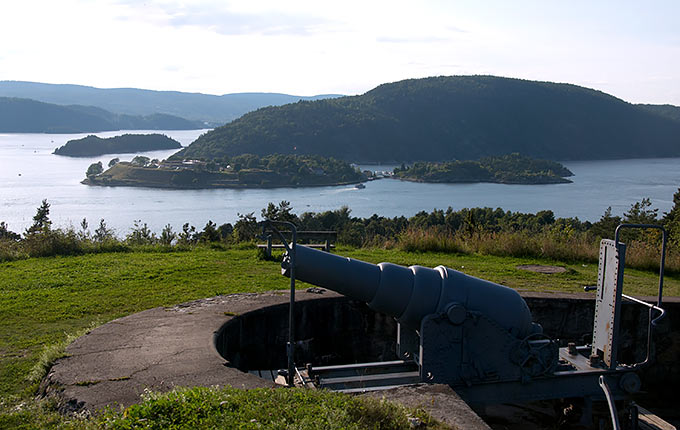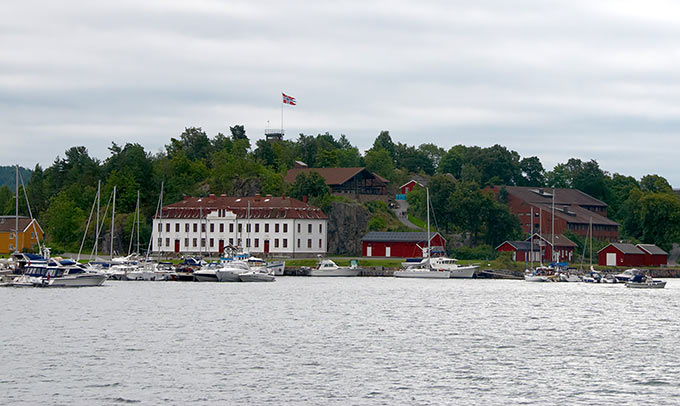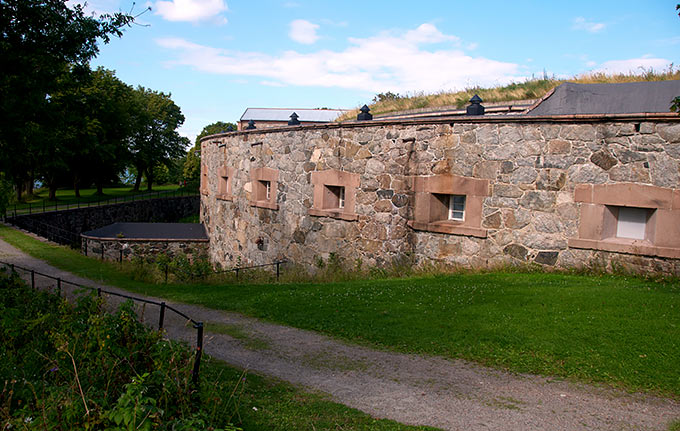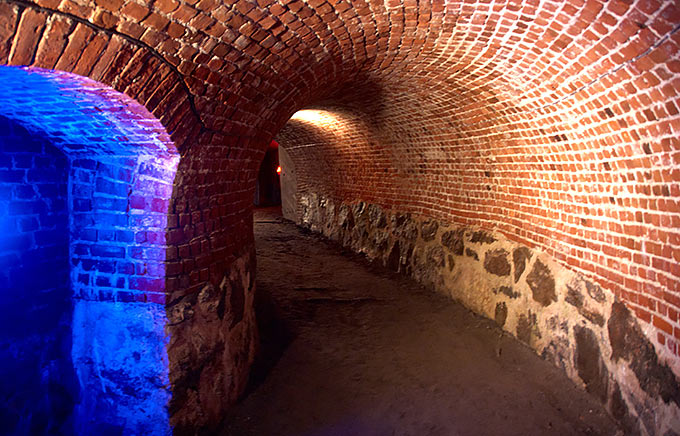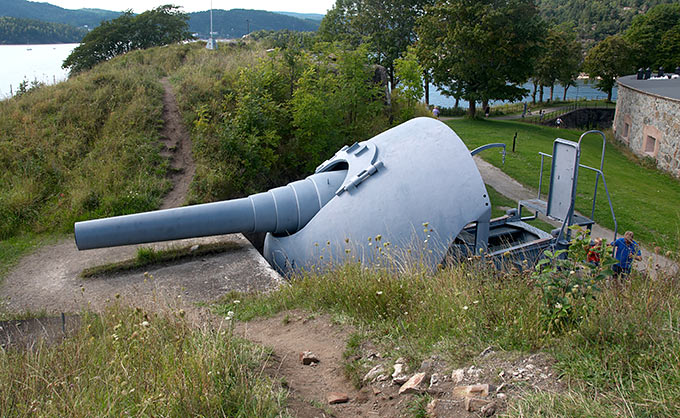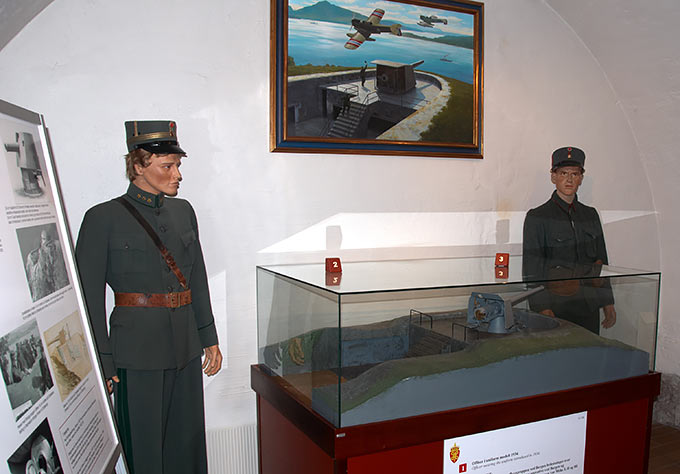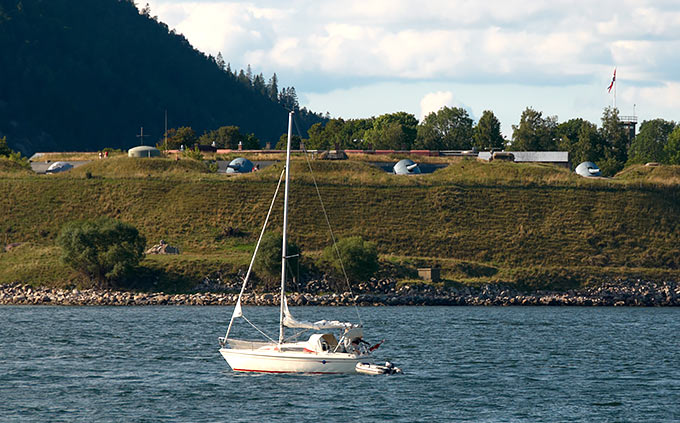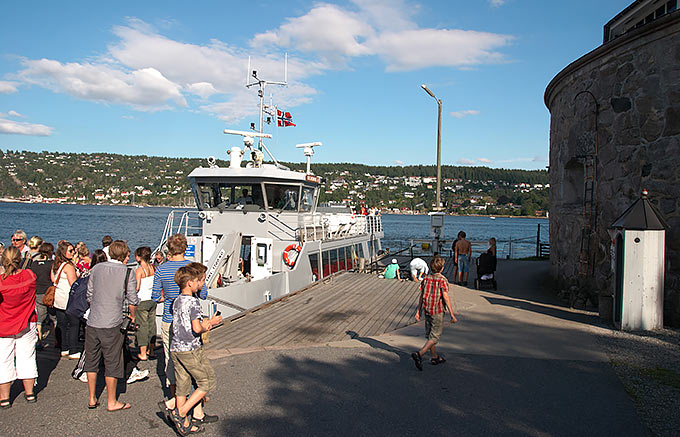Oscarsborg fortress - the fist of the Oslofjord
Such nickname had this fortress in the good old days. It is located in a ravine Drøbakzund, on two island North and South Kaholmen at the site created by nature to protect the approaches to the Norwegian capital.
The first fortifications were erected here back in 1644 under Christian IV, King of Denmark and Norway, as a primitive artillery blockhouses. It was made during the Swedish-Danish war 1643–1645. After that war, the fortifications were demolished.
In the early 1840s, when the Swedish King Oscar I (Norway was then part of Sweden), a project protection Christiania (as Oslo town was called) was prepared by engineer captains Broch and Irgens.
The project included the construction of the Main Fort in shape of an artillery Montalamber's tower and two casemated batteries - West and East, and auxiliary open South battery. Works began in 1846 with the construction of the auxiliary Coastal Fort at the pier of east cost of South Kaholmen. The fort was intended for 5 7-inch bombing guns in casemates.
In 1848 construction of the Eastern and Western Coastal casemated batteries on 8 10-inch bombing guns each was completed, and in 1856 Main Fort was commissioned. Oscarsborg has become one of the strongest marine fortress in Northern Europe.
In the 1870s the fortress was rearmed with new rifled guns. Main Fort got 8-inch Armstrong guns M/1854, Eastern and Western coastal batteries - 5-inch Palliser guns Palliser. A new East battery for two 8-inch Armstrong guns was erected to the east of the Main fort. South battery was considerable rebuilt for installation of new Swedish made 22.6 cm guns. Strait to the west of South Kaholmen island was blocked by the underwater wall made of 30 tons granite blocks.
The development of rifled artillery demanded a thorough reconstruction of the fortress. Gun ports of the Main fort were sealed and thick earthen banquet was erected in front of its frontal walls. Finally, in 1875-1893 to the south of the Main Fort the new South (or Main) battery was constructed and armed with two 8-inch Armstrong guns, one 12-inch Krupp L/22 M1877 gun and three new 28 cm Krupp guns M1891, which got Jewish names - Aaron, Moses and Joshua.
In 1875 a minefield was installed in Drobaksund strait with control station at South Kaholmen island. In 1892 to 4 57-mm Swedish Finnspong guns were mounted at South Kaholmen to cover these fields.
In 1890 construction of axillary batteries began on the high banks of Drøbaksund strait - Husvik 57 mm battery, Kopås battery with three 15 cm Armstrong guns, Håøya island 28 cm battery, and others. At the same time, construction of infantry strongholds of the land defense of the fortress was completed. Machine-gun anti-air balloon batteries were also installed in the fortress.
Target spotting for guns of the fortress was carried out by means of the so-called "orographs" - Sweden-Norway's distance-measuring system. In 1896 an orographpavilion was built in the North Kaholmen island, and in 1906 two new stations on the shores of the Oslofjord in the 15-20 km. to the south were constructed. In the early 1900s the fortress got four 90-110 cm spotlights - two at Kaholmen islands, and the other two in the villages Drøbak and Nesset.
In 1899-1901 the first of the Norwegian underwater torpedo battery with three launchers for Whitehead torpedoes was installed on North Kaholmen island.
In 1905 phone lines connected batteries, central fire post and orograph stations of Oscarsborg fortress. In 1916–1917 batteries around Drøbaksund were modernized, and AA batteries were rearmed with 75 mm Canet duns..
After the First World War, Norwegian military budget was gutted. Norway at the time was a very poor country, besides the main effort on national defense have been moved to the border forts and mine artillery defenses at the entrance of the Oslo Fjord.
There were no modernization of Oscarsborg's fortifications in this period, moreover, a row of external batteries were disarmed, which was noticed in German intelligence. However, Oscarsborg play a decisive role in the events of the Second World War. His glory hour came in April 1940.
At 4 am, April 9, 1940, a column of German ships led by the heavy cruiser "Blucher" tried to secretly get to Oslo. They were convinced that Oscarsborg not dare to open fire from their old guns. It was a big miscalculation.
Volleys of 280-mm guns of Main battery, and the batteries Husvik (57 mm) and Kopås (150 mm) knocked out the fore 203 mm gun turret of the cruiser "Blucher" his steering and a sprinkler system, a fire broke out on board and ammunition began to explode. Two torpedoes from the torpedo station on North Kaholmen finished the once mighty warship.
At 6 am "Blucher" sunk with more than half it's crew and passengers, and all the column had to turn back and land in the 50-km distance to the south. Due to this delay the Storting (Norwegian parliament), the government and the king were able to evacuate in time from Oslo to the north and continue the fight.
During German occupation, in Oscarsborge was a German training center and some kind of recreation for the troops that were designated for the Eastern front. A May 12, 1945, the Norwegian flag was raised again at the fortress, and it was the same one that flew over it in April 1940.
After the war, Oscarsborg was the last line of defense of the capital of Norway. The fortress get a new battery of 105 mm guns BSKA. However, with the demise of the Soviet Union the world has changed. In 1989 the minefields in the Oslo fjord were taken off, in 1993 torpedo and artillery batteries in Oscarsborg were finally disarmed. Till 2002 Coastal Artillery school and training facilities of Norwegian Navy stationed in Oscarsborg,
In 2002 the whole territory of the fortress was handed over to the civil authorities for the development of culture and tourism.
Impressions
What can I say - I've got very good impressions. It was a nice experience to sail by the ferry on the Oslo Fjord with its beaches, yachts, houses, and splendid Norwegian nature all around. The central fortress is a sample of how society could benefit from old fortifications that were not scraped and dismantled for building materials. There are museums and cultural center and opera house, and the beaches, marinas and berths for yachts and boats, and children's playgrounds, cafés, etc.
Also it's need to note that Oscarsborg fortress is not limited with two Kaholmen islands - there are several tens of other objects (batteries, bunkers, strongholds) on the banks of Drobakzund Strait. Oscarsborg is a sea fortress and a full-strengthening fortified district, which is still waiting for its thoughtful researchers and descriptors.
I personally would be glad to take on this important job, as soon as the financing issue will be resolved...
Land forts and fortress:
Bip Castle Gatchina Ivangorod Izborsk Kexholm Kirillov Monastery Koporye Novgorod Pechorskiy Monastery Peter&Paul Fortress Porkhov Pskov Schlisselburg Staraya Ladoga Tikhvin Vyborg Hameenlinna Hamina Kastelholm Kymenlinna Lappaenranta Raseborg Castle Savonlinna Tavetti Turku Visby Fredrikstadt Fredriksten Hegra Fort Hoytorp Fort Arensburg Narva Tallinn Antipatris Caesarea Jerusalem Latrun Fort Masada
Sea forts and fortresses:
Alexander Fort Ino Fort Krasnaya Gorka Fort Kronstadt: Kotlin isl. Kronstadt: North Forts Kronstadt: South Forts Trongsund Hanko Svartholm Sveaborg Marstrand Siaro Fort Vaxholm Oscarsborg
Artillery batteries and individual guns:
Coastal Artillery Hemso Fort
Fortified areas and defensive lines:
Karelian Fortified Area (KaUR) KrUR Leningrad Mannerheim Line Nevsky Bridgehead VT Line Harparskog Line Salpa Line Gothland
Russian
S e a r c h All news

